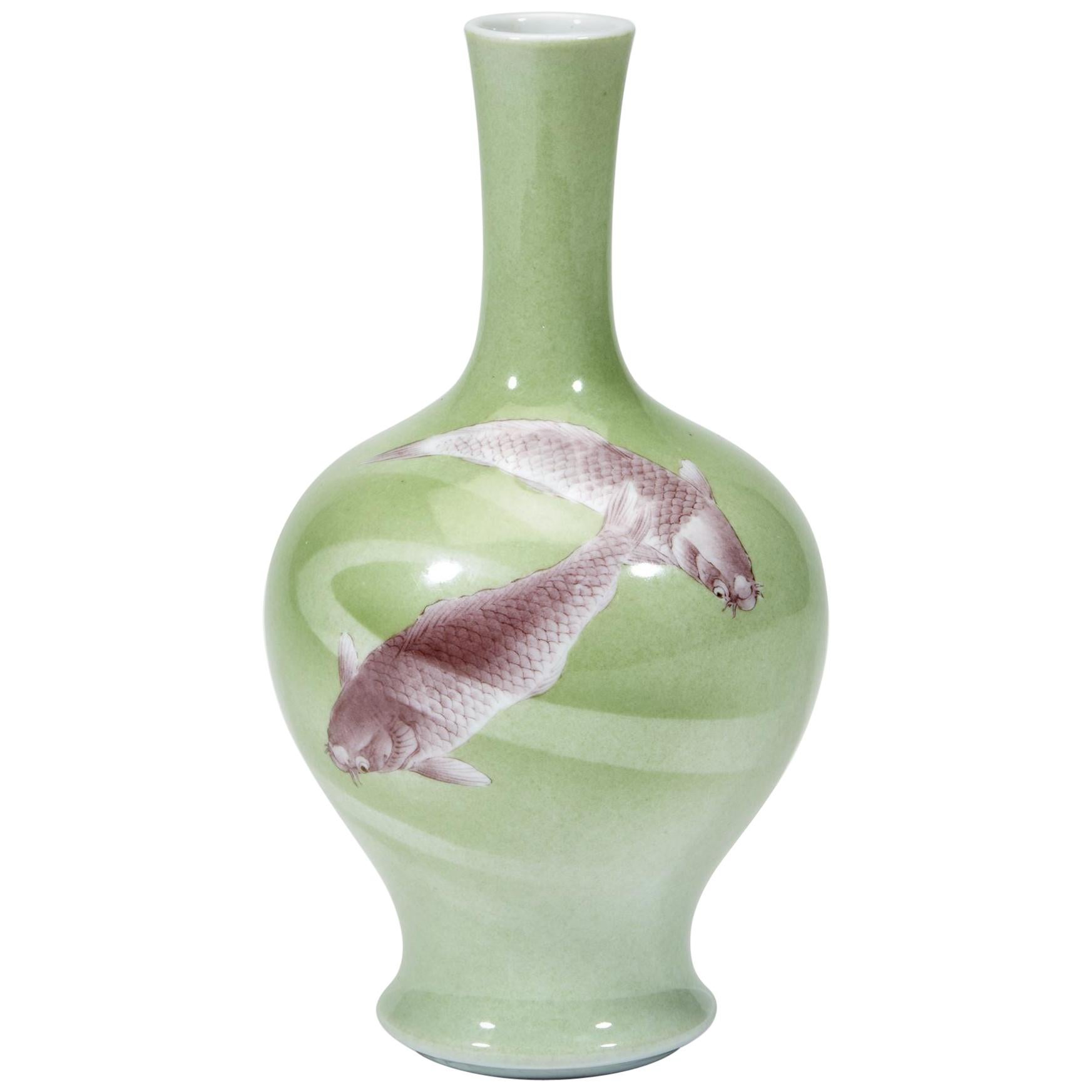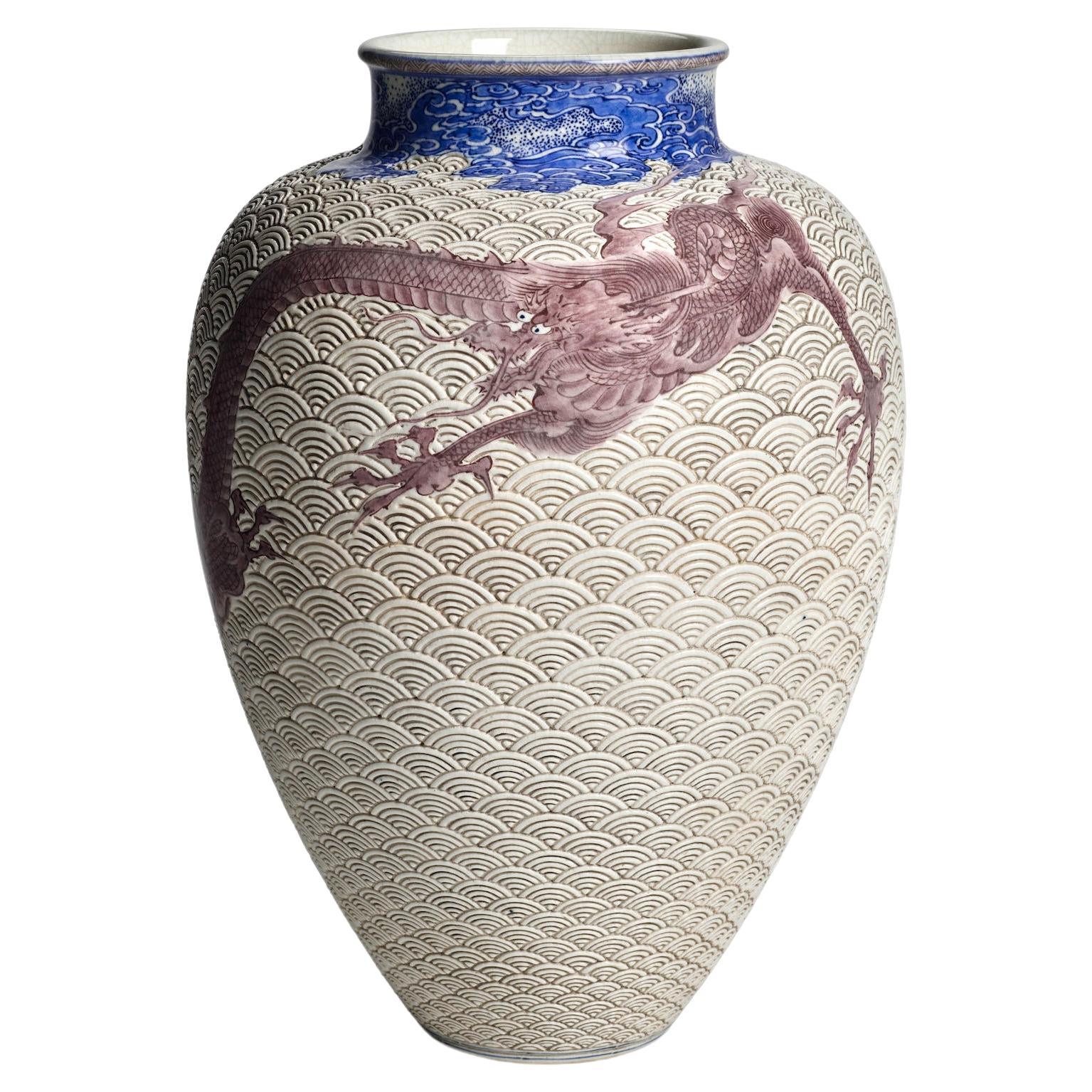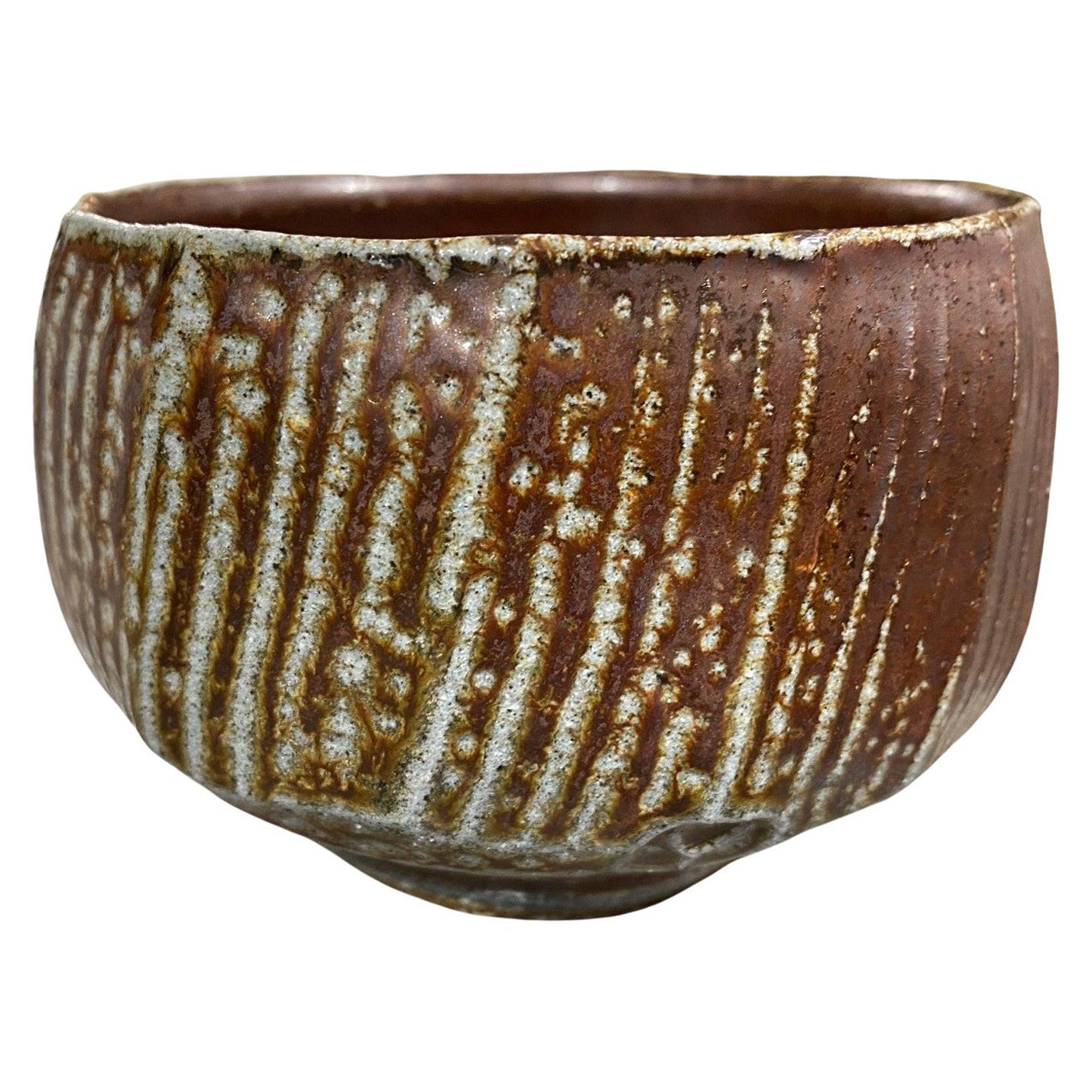Items Similar to Makuzu Kozan II Signed and Stamped Japanese Ceramic Flower Pottery Bowl Pot Vase
Want more images or videos?
Request additional images or videos from the seller
1 of 8
Makuzu Kozan II Signed and Stamped Japanese Ceramic Flower Pottery Bowl Pot Vase
About the Item
A beautiful handmade handled bowl by well-known Japanese ceramic artist Makuzu Kozan II, son of Makuzu Kozan who was appointed artist to the Japanese Imperial household and was one of the major potters of the Meiji Era. Makuzu Kozan II became his father's natural successor. Makuzu Kozan II died in the aerial bombings of Yokohama when the Makuzu kiln and family showroom were destroyed. This work is glazed and finely decorated with a floral motif. Amazingly rich colors.
Signed and stamped (in base) by Makuzu Kozan II.
His work can be found in The British Museum amongst other museums and private collections.
Would be a great addition to Japanese or Asian ceramic collection or very eye-catching stand-alone work in any setting. His work is becoming rare and scarce.
Dimensions: 9.5" high, 8" diameter.
- Creator:Makuzu Kozan II (Artist)
- Dimensions:Height: 9.5 in (24.13 cm)Diameter: 8 in (20.32 cm)
- Style:Showa (Of the Period)
- Materials and Techniques:
- Place of Origin:
- Period:
- Date of Manufacture:1930s
- Condition:In very good vintage condition with no discernable flaws, chips, cracks, etc... (please see photos). A small thumb indention on one side clearly intended by the maker. A truly gorgeous and unique work overall. Rare and scarce.
- Seller Location:Studio City, CA
- Reference Number:1stDibs: LU2254315953681
About the Seller
4.9
Platinum Seller
These expertly vetted sellers are 1stDibs' most experienced sellers and are rated highest by our customers.
1stDibs seller since 2016
766 sales on 1stDibs
Typical response time: <1 hour
- ShippingRetrieving quote...Ships From: Studio City, CA
- Return PolicyA return for this item may be initiated within 7 days of delivery.
More From This SellerView All
- Japanese Asian Signed Stamped Large Ceramic Pottery Glazed Low Bowl ChargerLocated in Studio City, CAA gorgeous, substantial work. Beautifully designed and made. Signed/ chop stamped by the artist on the base. From a collection of Japanese and Asian ceramics and art. Dimens...Category
20th Century Japanese Showa Ceramics
MaterialsCeramic
- Tatsuzo Shimaoka Signed Japanese Glazed Rope Inlay Ceramic Pottery Bowl PlateBy Tatsuzo Shimaoka 2Located in Studio City, CAAn exquisitely decorated and wonderfully executed ceramic Mingei glazed plate/ low bowl by Japanese National Treasure and Mashiko pottery master Tatsuzo Shimaoka. This work displays his famous Jomon Zogan rope inlay design, hand-painted decoration, and has his impressed "Ta" signature on the base. Shimaoka, who started as an apprentice to famed Japanese potter Shoji Hamada in 1946 before opening his pottery studio, has exhibited worldwide including in North America, Asia, and Europe. In 1996 he was bestowed the title of Japanese Living Treasure...Category
Mid-20th Century Japanese Showa Ceramics
MaterialsEarthenware
- Japanese Asian Signed Studio Pottery Wabi-Sabi Ceramic Glazed Chawan Tea BowlLocated in Studio City, CAA stunning Japanese stoneware studio pottery chawan tea bowl that features a beautiful, heavy and sumptuously multi-glaze with wonderful shifts in color and texture. This bowl is wit...Category
20th Century Japanese Showa Ceramics
MaterialsStoneware
- Japanese Asian Signed Studio Pottery Wabi-Sabi Ceramic Glazed Chawan Tea BowlLocated in Studio City, CAA stunning Japanese stoneware Studio Pottery chawan tea bowl that features a beautiful dark rich glaze with wonderful shifts in pattern and texture. This particular piece encompa...Category
20th Century Japanese Showa Ceramics
MaterialsStoneware
- Japanese Asian Signed Studio Pottery Wabi-Sabi Ceramic Glazed Chawan Tea BowlLocated in Studio City, CAA gorgeous Japanese studio pottery chawan tea bowl that features a wonderful reddish-orange glaze with various shifts in colour and texture. This particular piece encompasses the...Category
20th Century Japanese Showa Ceramics
MaterialsEarthenware
- Shiko Shikou Munakata Rare Signed Japanese Pottery Chawan Tea Bowl Signed BoxBy Shikou MunakataLocated in Studio City, CAAn exceptionally rare, wonderfully designed Chawan tea bowl by famed Japanese master woodblock printmaker/ artist Shiko Munakata (1903-1975) who is widely considered to be the most important Japanese visual artist of the 20th century and the Pablo Picasso of Japan. This hand-painted work clearly illustrates Munakata's whimsical side as it is of a Koma - a child's spinning top toy. Very few examples of Munakata's work in ceramics exist still today. The work is signed by Munakata on the base as well as the original wood protective storage box (his seal can also be seen faintly in the lower-left corner). The bowl has a small kintsugi or "golden joinery" repair - the Japanese art of repairing broken pottery by mending the areas of breakage with lacquer dusted or mixed with powdered gold - on the inside. As a philosophy, it treats breakage and repair as part of the history of an object, rather than something to disguise. Munakata who is often compared to Picasso was primarily associated with and a principal figure in both the Sosaku-Hanga (which stressed the artist as the sole creator ) and the Mingei (folk art) movements. His many accolades and awards include the "Prize of Excellence" at the Second International Print Exhibition in Lugano, Switzerland in 1952, and first prize at the São Paulo Bienal Exhibition in Brazil in 1955, followed by the Grand Prix Award at the Venice Biennale in 1956, and the Order of Cultural Merit, the highest honor in the arts by the Japanese government in 1970. In 1960 after returning from a year abroad exhibiting his work in the United States, the Horinji Temple in Kyoto bestowed upon him the honorary rank of “Hokkyo”. In 1962, he received the rank of “Hogan” from Nisseki Temple in Toyama prefecture. He also received a Medal of Honor in 1963 and the Asahi Shimbun culture prize in 1965. Munakata's work can be found in numerous international collections and museums including: The Britsih Museum, UK The Chicago Art Institute Museum of Modern Art (MOMA), NY The Metropolitan Museum of Art (The Met), NY The Philadelphia Museum of Art The Smithsonian American Art Museum (SAAM), Washington DC Kemper Art Museum, St. Louis And his own museum The Munakata Shiko...Category
Mid-20th Century Japanese Showa Ceramics
MaterialsCeramic
You May Also Like
- Japanese Ceramic Bowl Makuzu Kozan Utusushi KenzanBy Makuzu KozanLocated in Atlanta, GAA rare ceramic bowl with over glaze painted decoration by Japanese imperial potter Makuzu Kozan ((1842–1916). Unlike the better known works Kozan made for the expositions in the west and export to the foreign market, this piece exemplifies his work for the domestic market and the tea ceremony. The bowl was made in the so called "Utusushi" Ogata Kenzan (1663-1743), an celebrated Edo painter and ceramicist. Utusushi is loosely translated as "in the spirit of". It is not at all a simple imitation of a master, but a Japanese concept of embracing the spiritual essence of a master while the creator is free to mix in his or her own unique artistic interpretation and flavor. The bowl was made to hold fruits during the tea ceremony. It has a very distinguished form with a circular lower body morphing into a square upper portion that further opening with flared rim. The surface has a grey glaze onto which Asagao flowers (Japanese morning glory) on the vines were painted in a free and poetic style. White was used for the petals, green for the leaves with touches of gold highlight. Asagao, the symbol of the summer was rendered in the spirit of Ogata Kenzan, and interestingly the shape of the blossom echoes the unique form the bowl. It was likely reserved for the tea ceremony during the summer months. Under the base, Kozan was signed in black on an white porcelain plaque inlay. For two similar examples of Kozan's work Utusushi Kenzan, see Page 168-169 of the book: Sekai ni Aisa Reta ya Kimono Miyagawa Kozan Makuzu...Category
Antique Early 1900s Japanese Japonisme Ceramics
MaterialsCeramic
- Fine Japanese Ceramic Vase Makuzu Kozan Meiji PeriodBy Makuzu KozanLocated in Atlanta, GAA Japanese long neck porcelain vase circa 1900-1910s by the studio of Miyagawa Kozan (1842–1916), one of the most established and collected Japanese ceramist from the end of Meiji Period. Commonly known as Makuzu Kozan, which also appears as the signature on his work, his originally birth name was Miyagawa Toranosuke. He was the appointed artist to the Japanese Imperial household and his work was exhibited in many international fairs that the Meiji government participated at the turn of the century. This vase features an elegant Classic form with a slender neck and slightly flared mouth above a baluster body. It was finely painted with two swimming carps in a copper red underglaze among green ribbons like waves. The background display a brilliant verdant green overall, Around the fish a poetic hazy effect was emphasized for a visual complexity by Fuki-e (the blow painting), an invention in Kozan's studio. The new technical development of chemical colors from the west was embraced circa 1900s in Kozan studio. This empowered the more creative experiments with not only colors, but also concept of dimension, which led Makuzu Kozan's work to become a bridge between East and West aesthetics. This is particularly evident in this vase with the Masterly details of the brush strokes, the expertly employment of gradient of color, and a very realistic and detailed rendering of the fish and their vivid motions. For two similar examples of Kozan's work with similar carps decoration, see Page 148-149 of the book: Sekai ni Aisa Reta ya Kimono Miyagawa Kozan Makuzu...Category
Early 20th Century Japanese Meiji Ceramics
MaterialsCeramic
- Large Japanese Ceramic Vase by Makuzu Kozan Meiji PeriodBy Makuzu KozanLocated in Atlanta, GAA large Japanese ceramic vase by the celebrated Meiji imperial potter Makuzu Kozan (1842-1916) circa 1880-1890s. Dated to his underglaze phase post 1887 after he successfully mastered the new colors available from the west and used them to the best advantage in his work deeply rooted in Japanese aesthetics. The vase has an impressive size and was potted in the classic baluster form with an elegant proportion. The surface is decorated using a combination of techniques of low relief sculpturing...Category
Antique Late 19th Century Japanese Meiji Ceramics
MaterialsCeramic
- Rare and Large Japanese Porcelain Vase Makuzu KozanBy Makuzu KozanLocated in Atlanta, GAA striking blue and white vase from the studio of Japanese Potter Makuzu Kozan, also known as Miyagawa Kozan (1842–1916), one of the most established and collected ceramist from Meiji Period. Born as Miyagawa Toranosuke, Kozan established his pottery studio in Yokohama around 1870s and later became one of the appointed artist to the Japanese Imperial household. His work was exhibited in many international fairs that the Meiji government participated at the turn of the century and won many grand prizes. With an impressively large size, this vase was likely made and reserved as a presentation piece for one of the many expositions the studio participated in the early 20th century. It was decorated with underglaze cobalt blue using the novel technique developed by Kozan called Fuki-e (the blow painting), in order to achieve the striking dimensional literary landscape known as "Mountain and Water". Being one of the most creative ceramists, Kozan started experimenting with new chemical colors from the West in the format of his porcelain glaze around 1880s. New colors allowed him to create underglaze designs that appeared bright, smooth and glossy. He even invented his own receipt of cobalt blue to achieve a much brighter yet softer shade, as evident on this vase. To create landscape that is realistic and dimensional, more common in the western paintings, he was inspired by the native Japanese ink painting technique developed around 1900 by Yokoyama Taikan...Category
Early 20th Century Japanese Japonisme Ceramics
MaterialsPorcelain
- Japanese Porcelain Vase Meiji Period Makuzu KozanBy Makuzu KozanLocated in Atlanta, GAA finely decorated and glazed Japanese porcelain vase by Makuzu Kozan (1842-1916) circa 1900s Meiji Period. The vase is of a classic bottle form with baluster body and short neck. It was decorated with underglaze white magnolia blossom on a pleasant celadon background. The stamens of the flower were artistically rendered in a low relief, giving the design a realistic appeal with the dimension. Miyagawa Kozan...Category
Early 20th Century Japanese Meiji Ceramics
MaterialsPorcelain
- Japanese Porcelain Vase Makuzu Kozan Meiji PeriodBy Makuzu KozanLocated in Atlanta, GAA striking blue and white vase from the studio of Japanese Potter Makuzu Kozan, also known as Miyagawa Kozan (1842–1916), one of the most established and collected ceramist from Meiji Period. Born as Miyagawa Toranosuke, Kozan established his pottery studio in Yokohama circa 1870s and later became one of the appointed artists to the Japanese Imperial household. His work was exhibited in many international fairs that the Meiji government participated at the turn of the century and won many grand prizes. Of a relatively large size, this vase is decorated with underglaze cobalt blue using the novel technique developed by Kozan called Fuki-e (the blow painting). As a result, the bamboos appear took on a three-dimensional quality as if appearing in a mist. Known as one of the most creative ceramists, circa 1887, Kozan started experimenting with new chemical colors from the West in the format of his porcelain glaze. New colors allowed him to create underglaze design that appeared bright, smooth and glossy. He even invented his own receipt of cobalt blue to achieve a much brighter yet softer shade, as evident on this vase. To create landscape that is realistic and dimensional, more common in the western paintings, he was inspired by the native Japanese ink painting technique developed around 1900 by Yokoyama Taikan...Category
Antique Early 1900s Japanese Japonisme Ceramics
MaterialsCeramic
Recently Viewed
View AllMore Ways To Browse
Rare Used Stamps
Vintage Craft Stamps
Ceramic Flower
Rare Vintage Stamps
Rare Stamps
Handled Bowl
Weller Stamped
Vintage Flower Stamps
Vintage Flower Stamp
Flower Pottery
Vintage Household
Vintage Asian Ceramics
Vintage Ceramics
Vintage Folk Art Ceramics
Vintage Ceramic Flowers
Vintage Ceramic Flower
Used Ceramics Kilns
Collection Showroom





